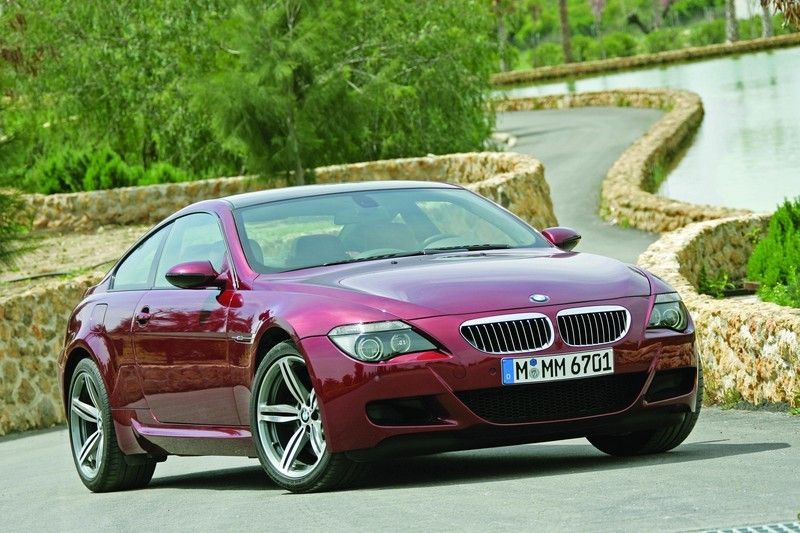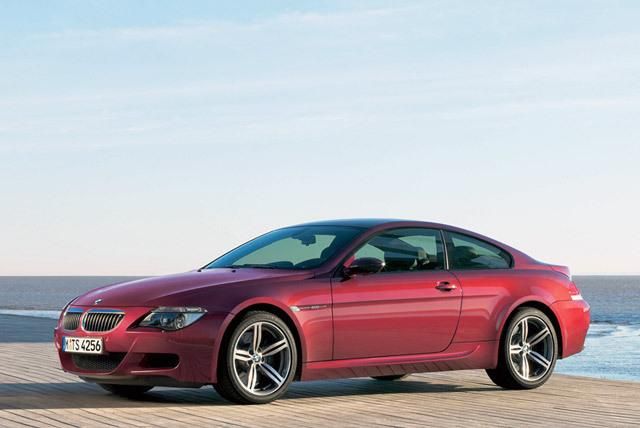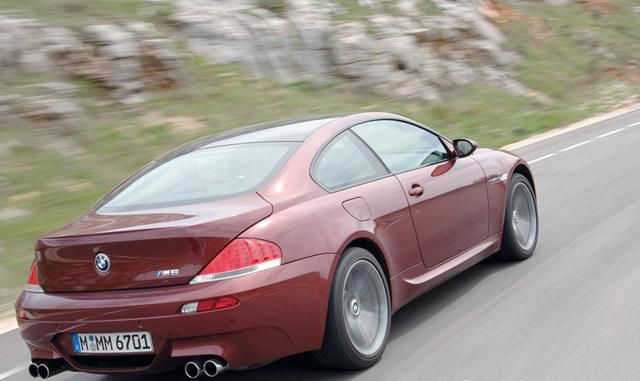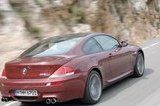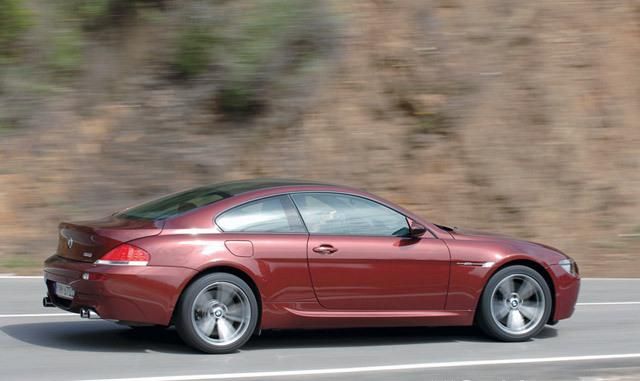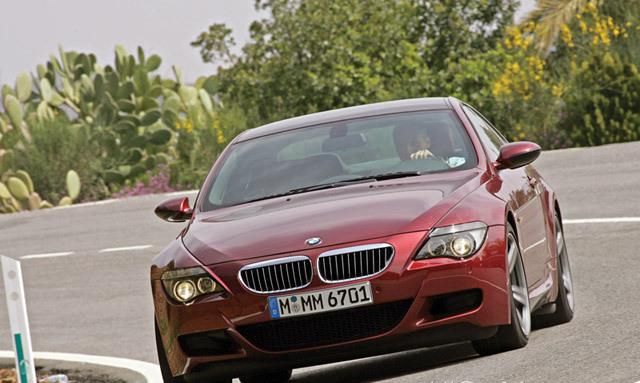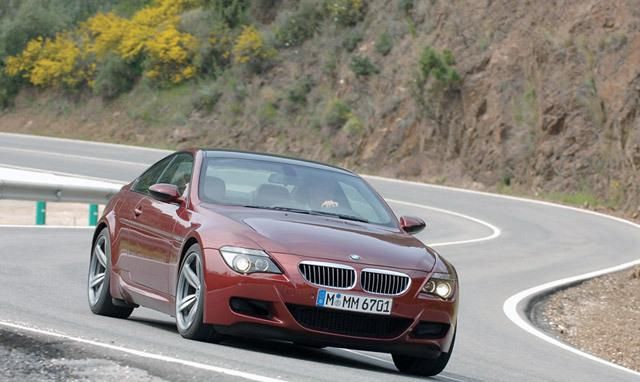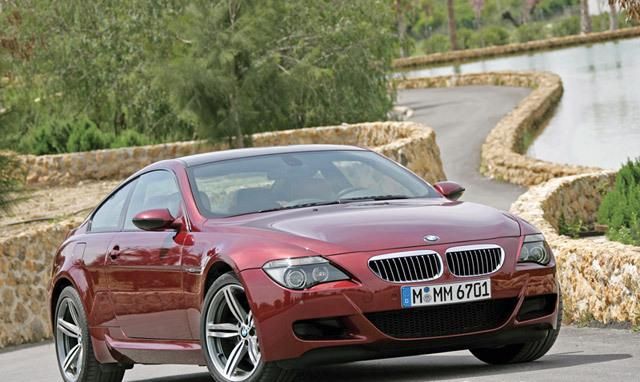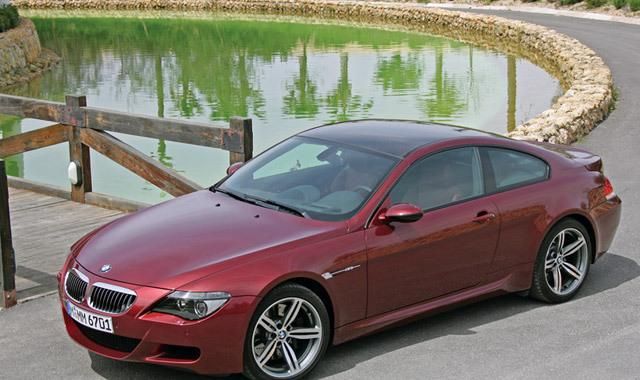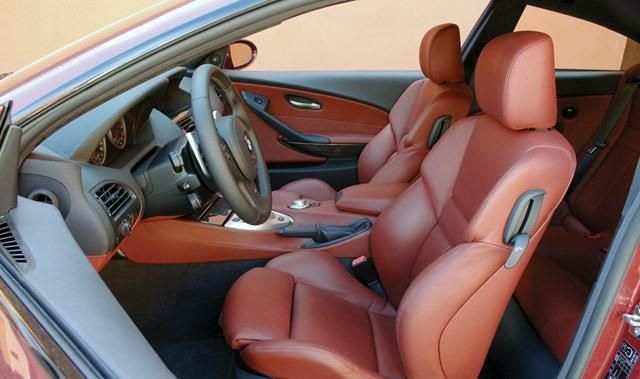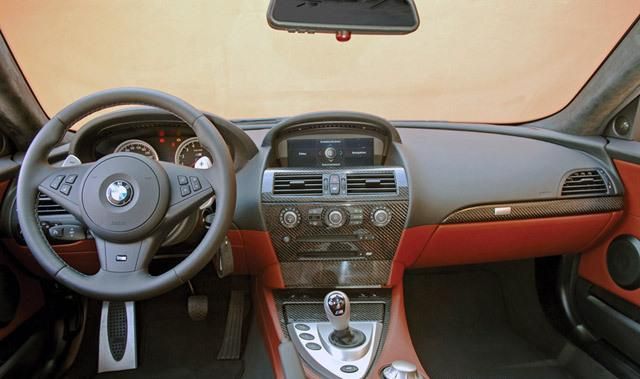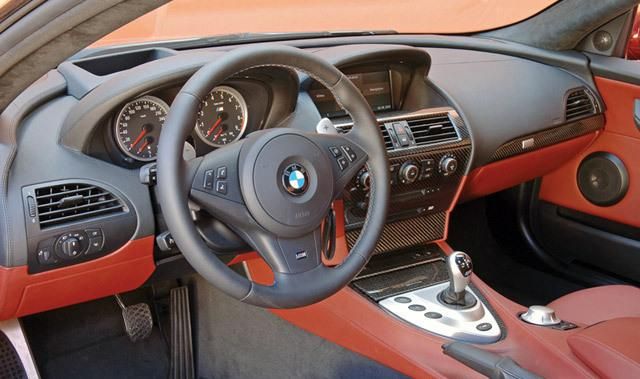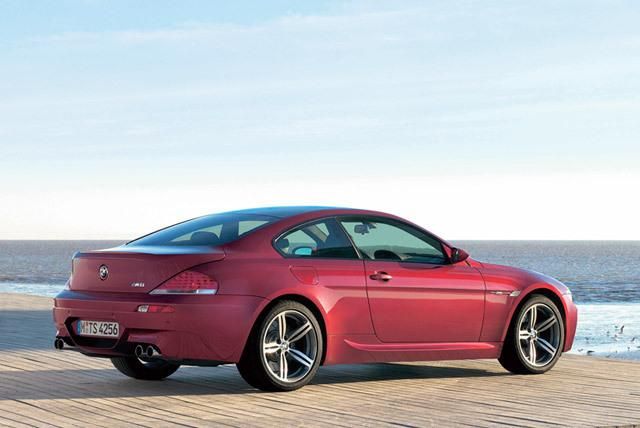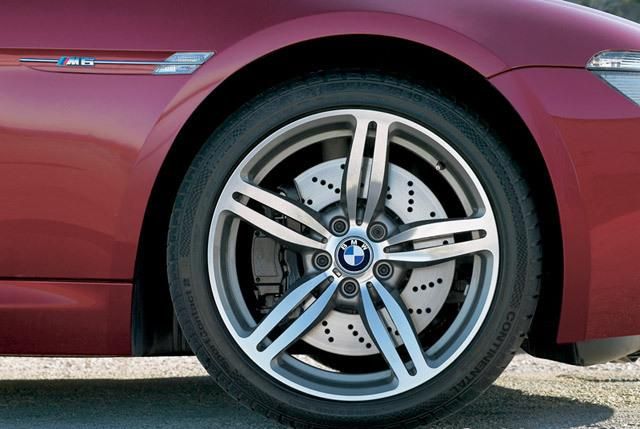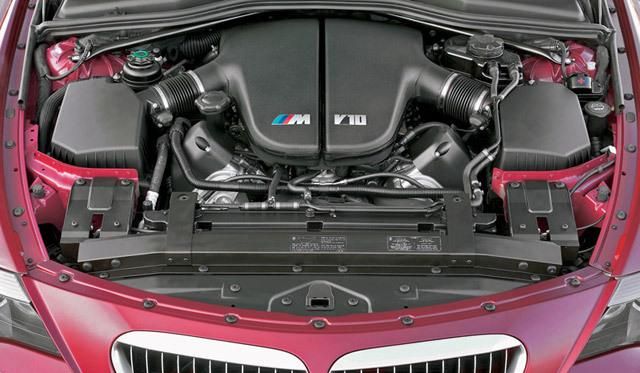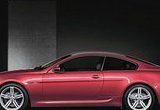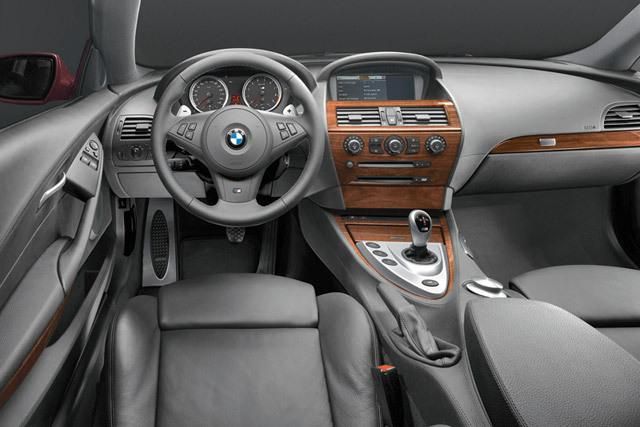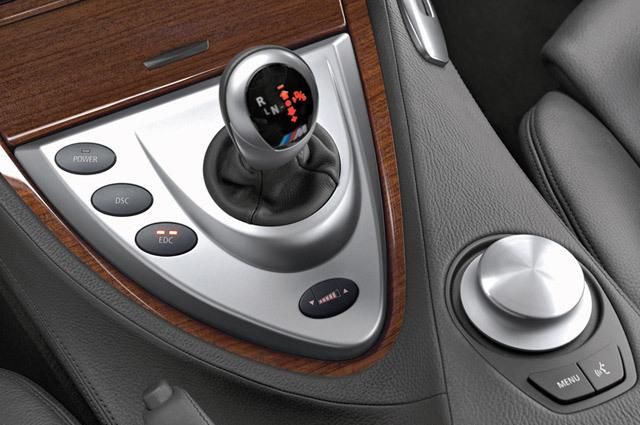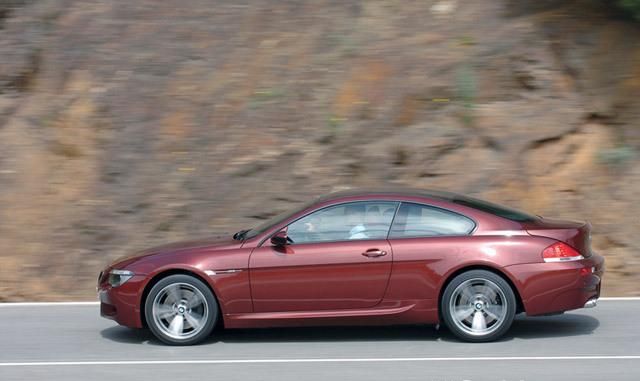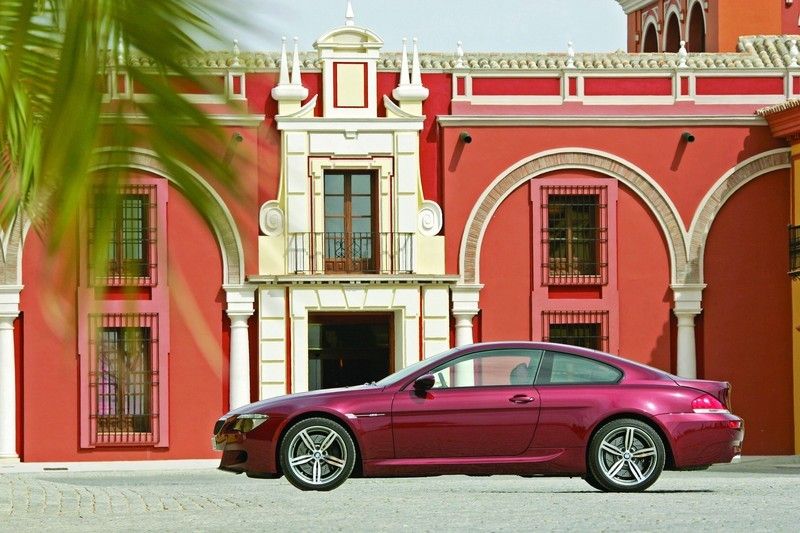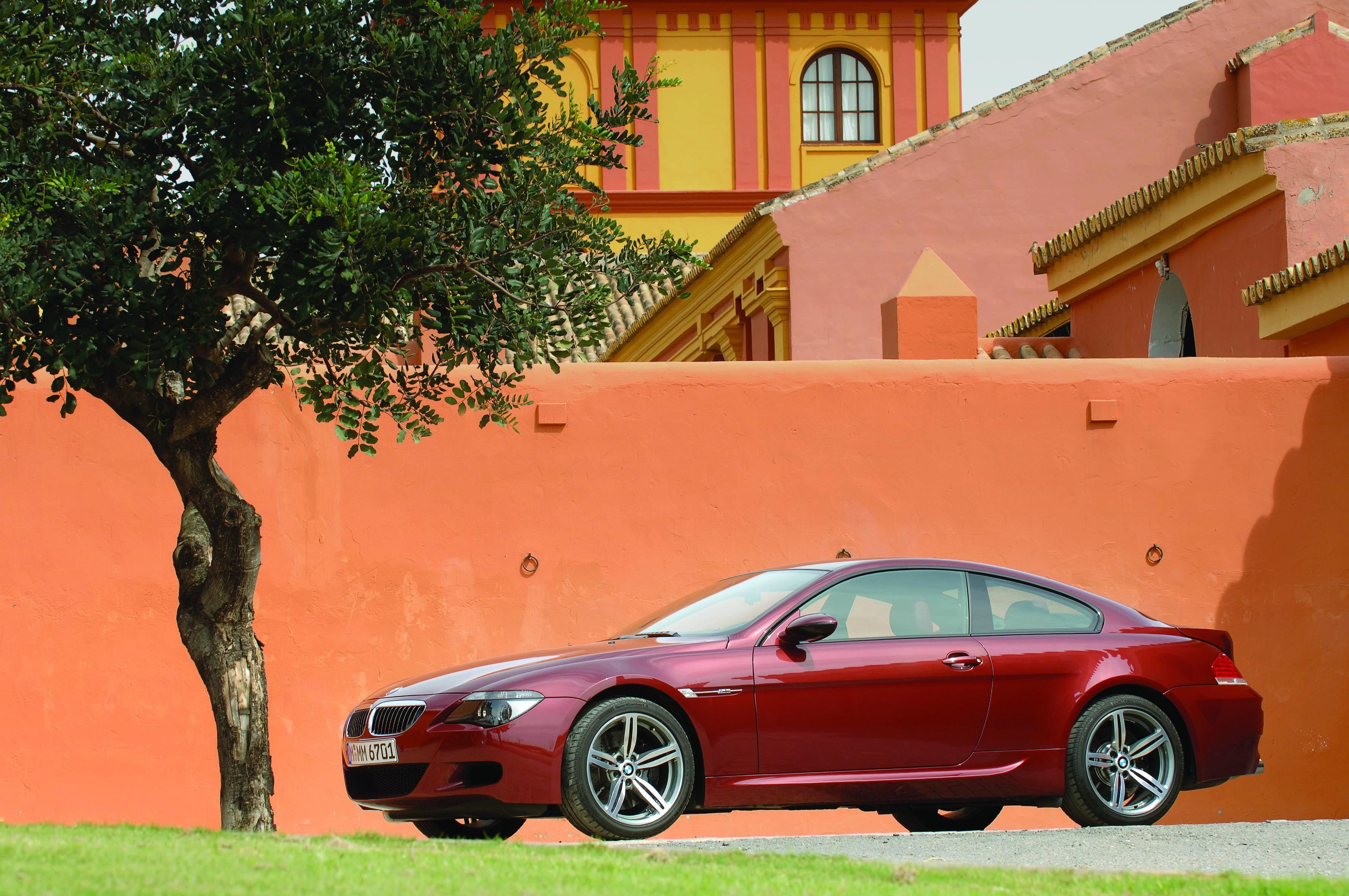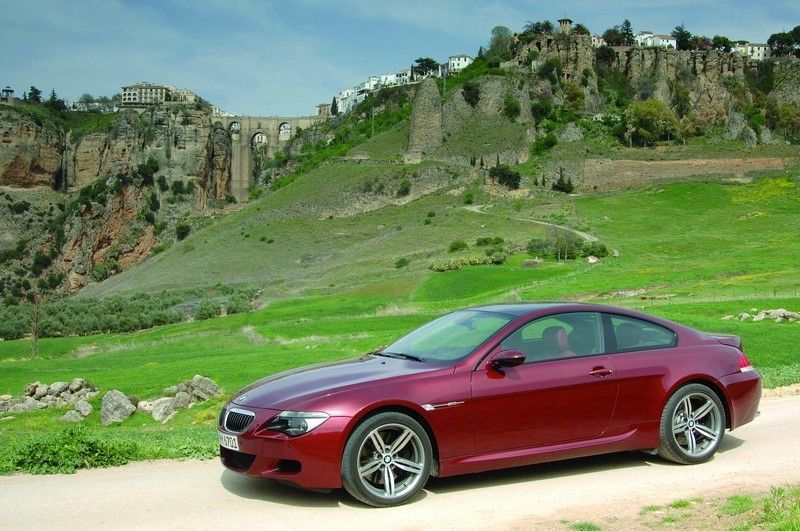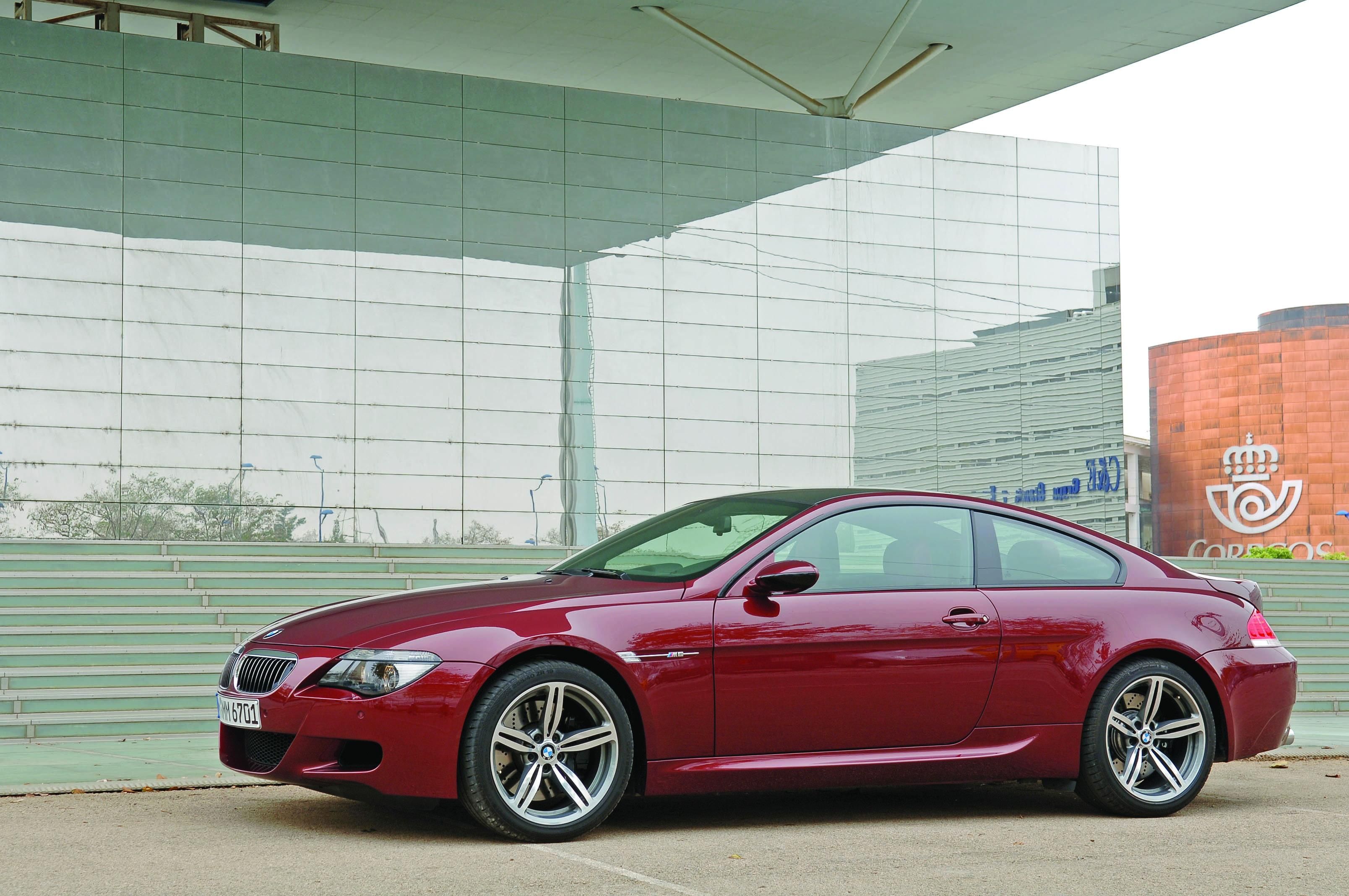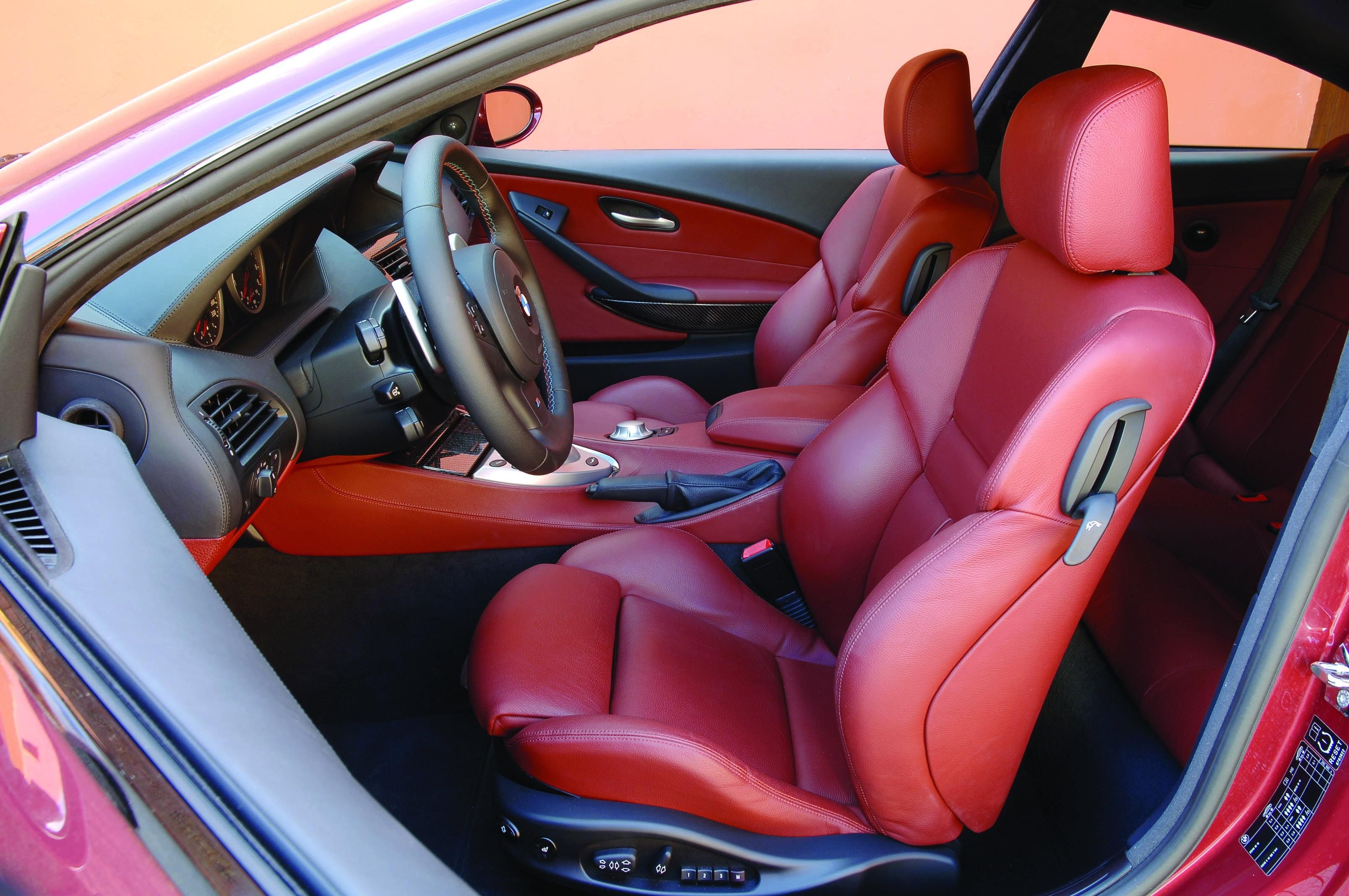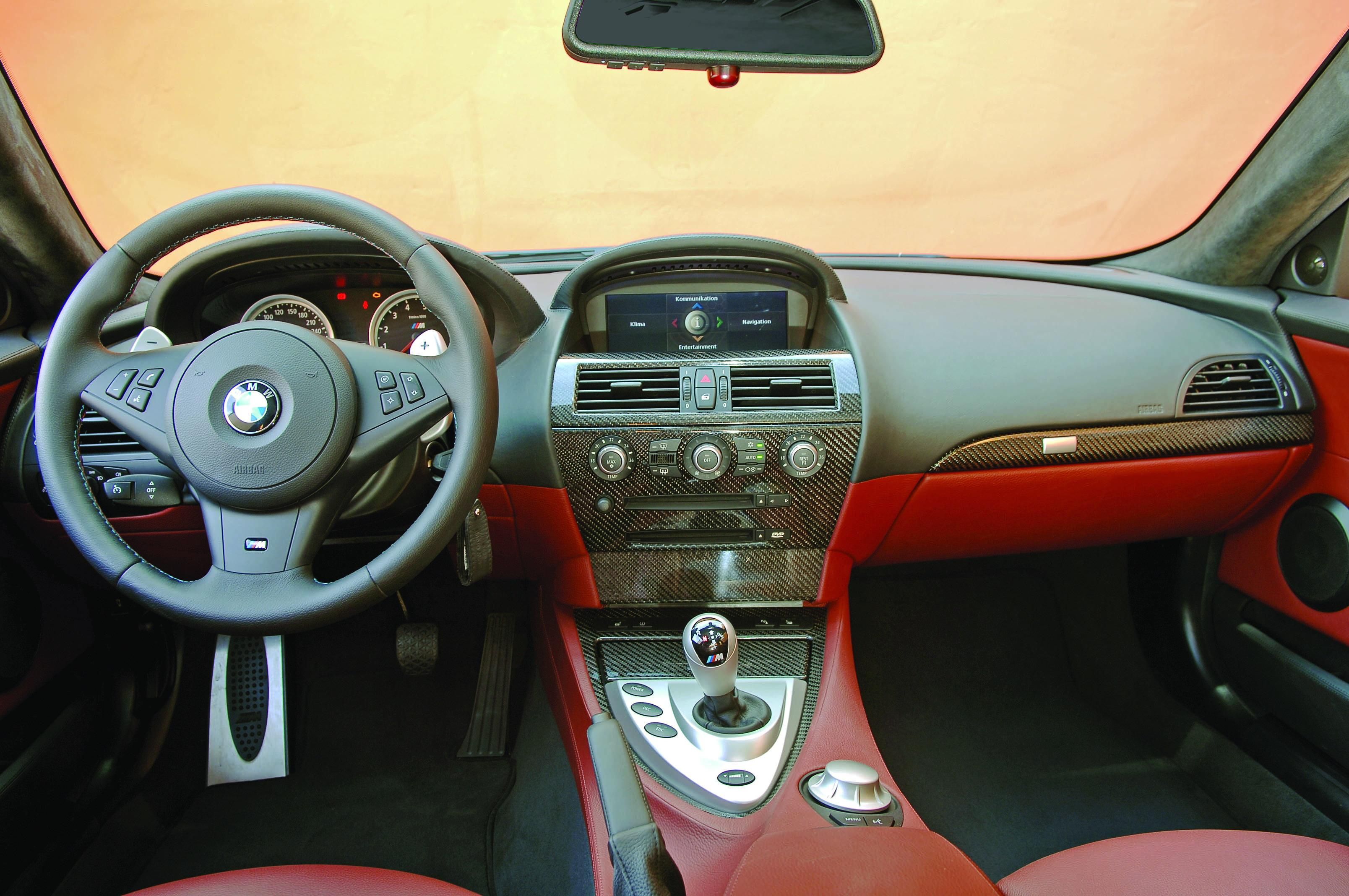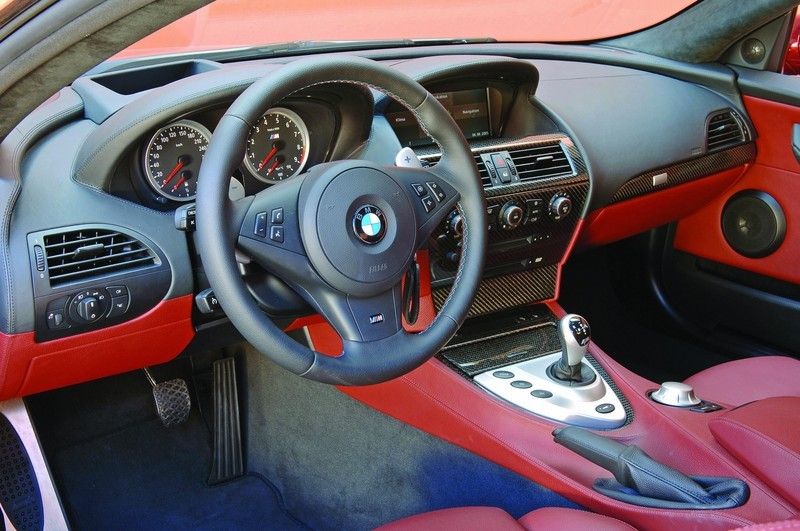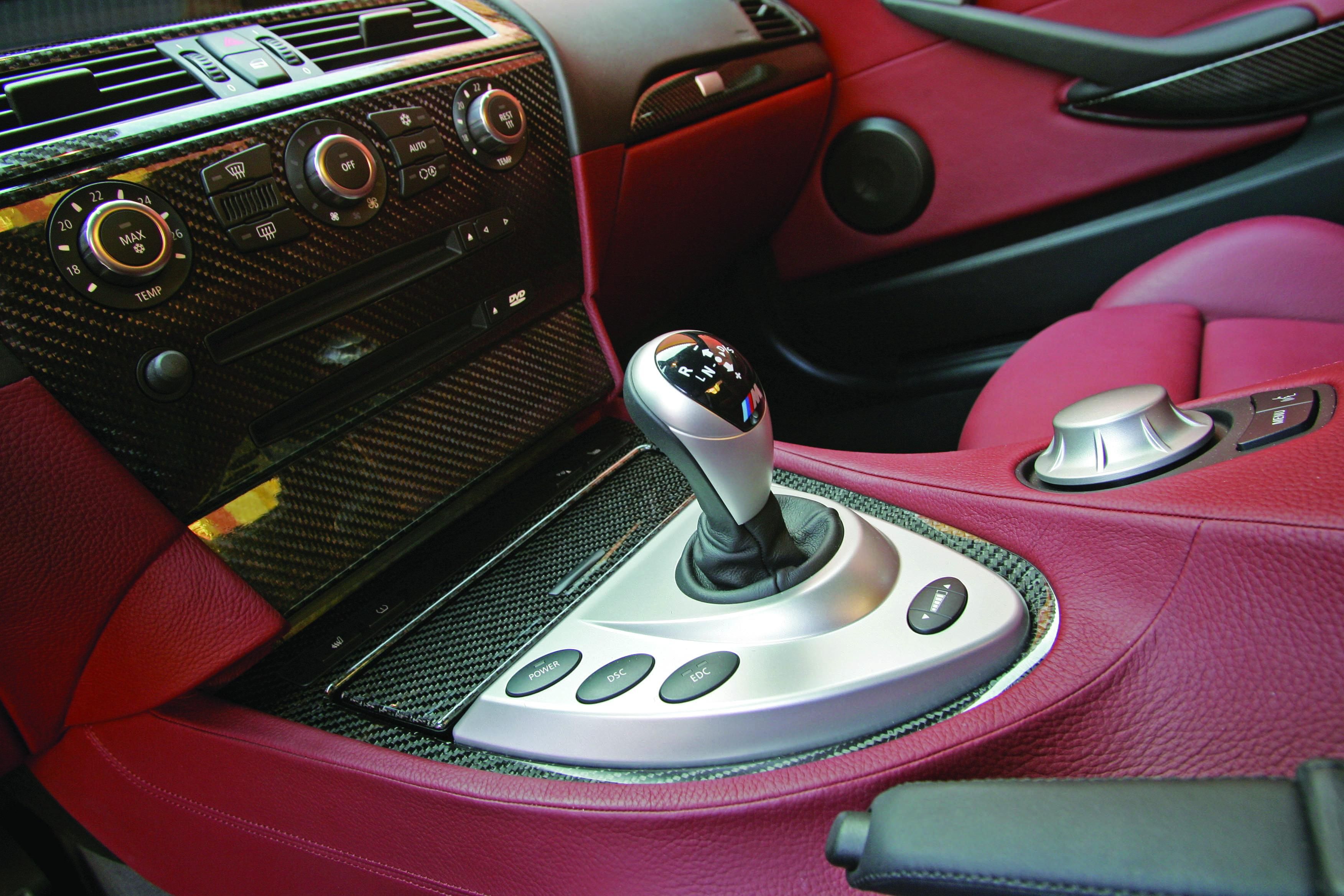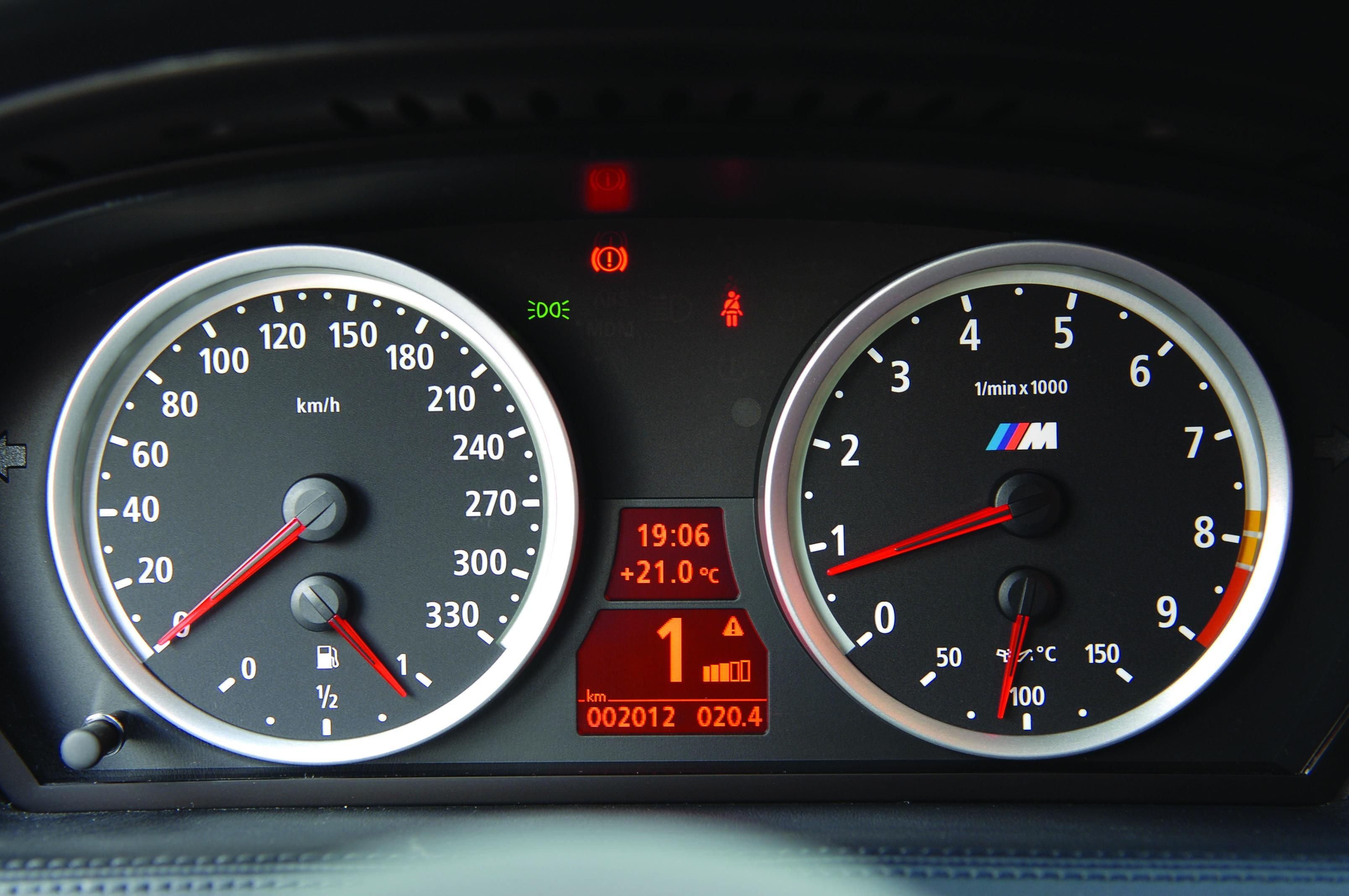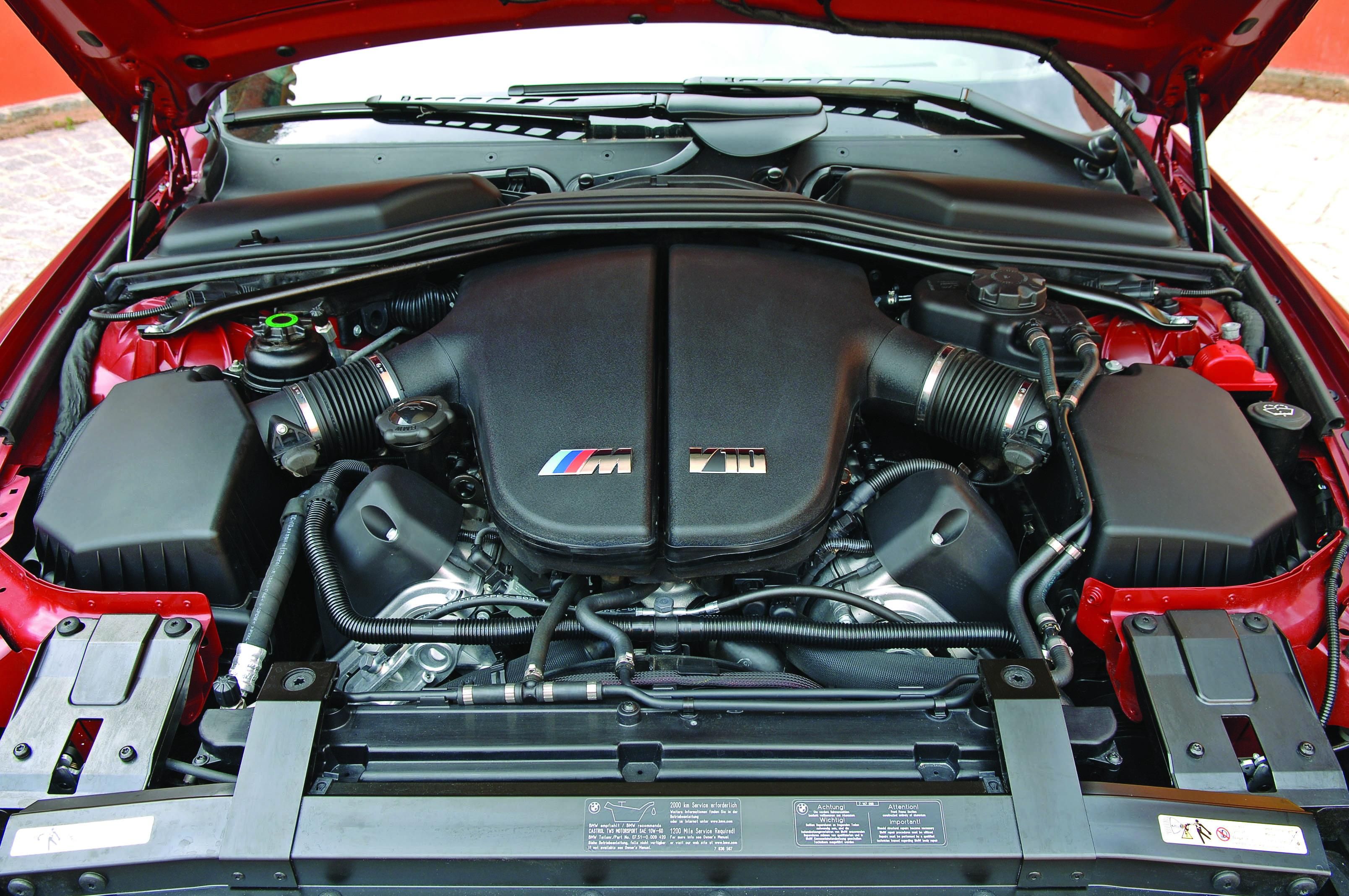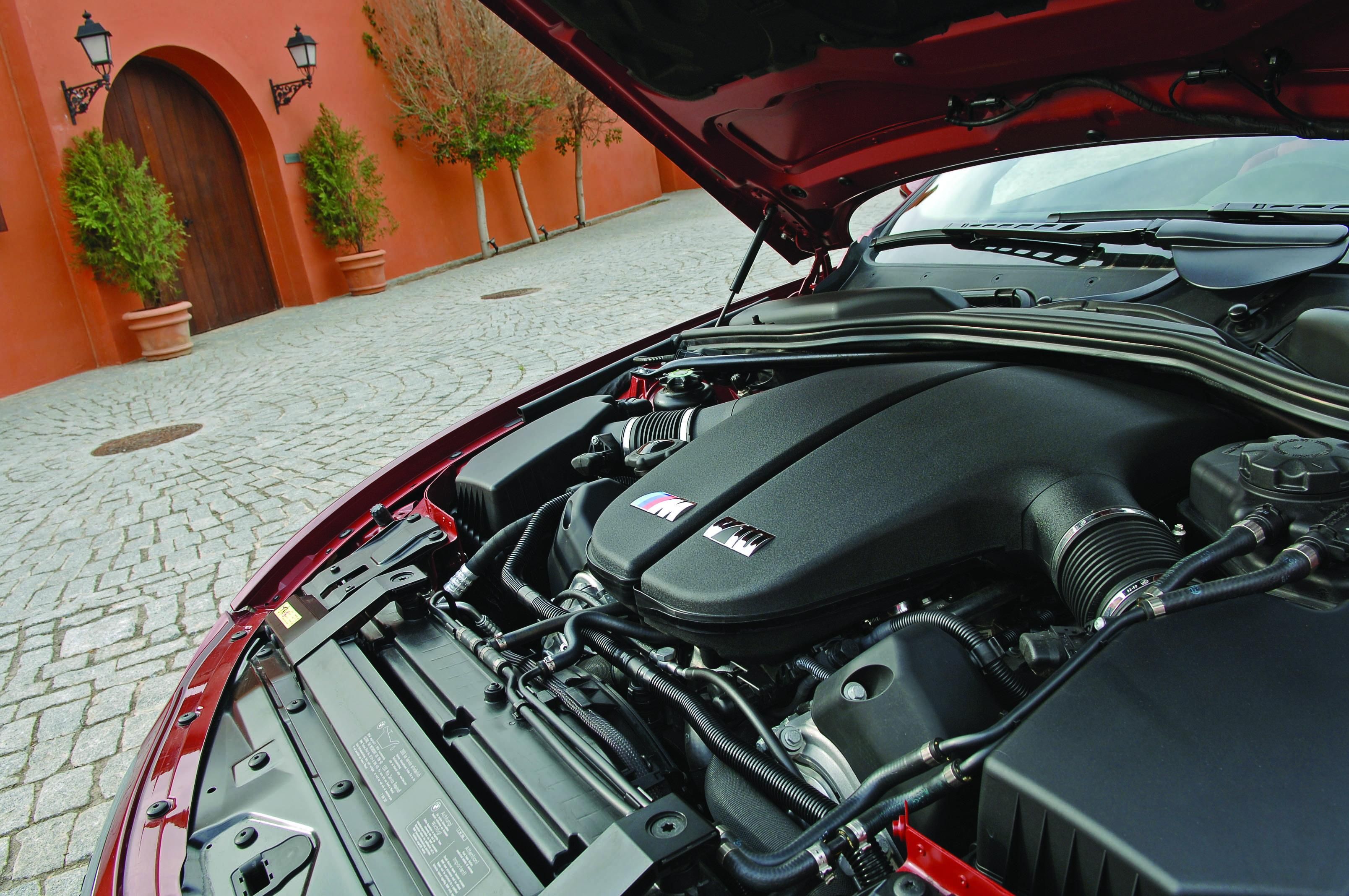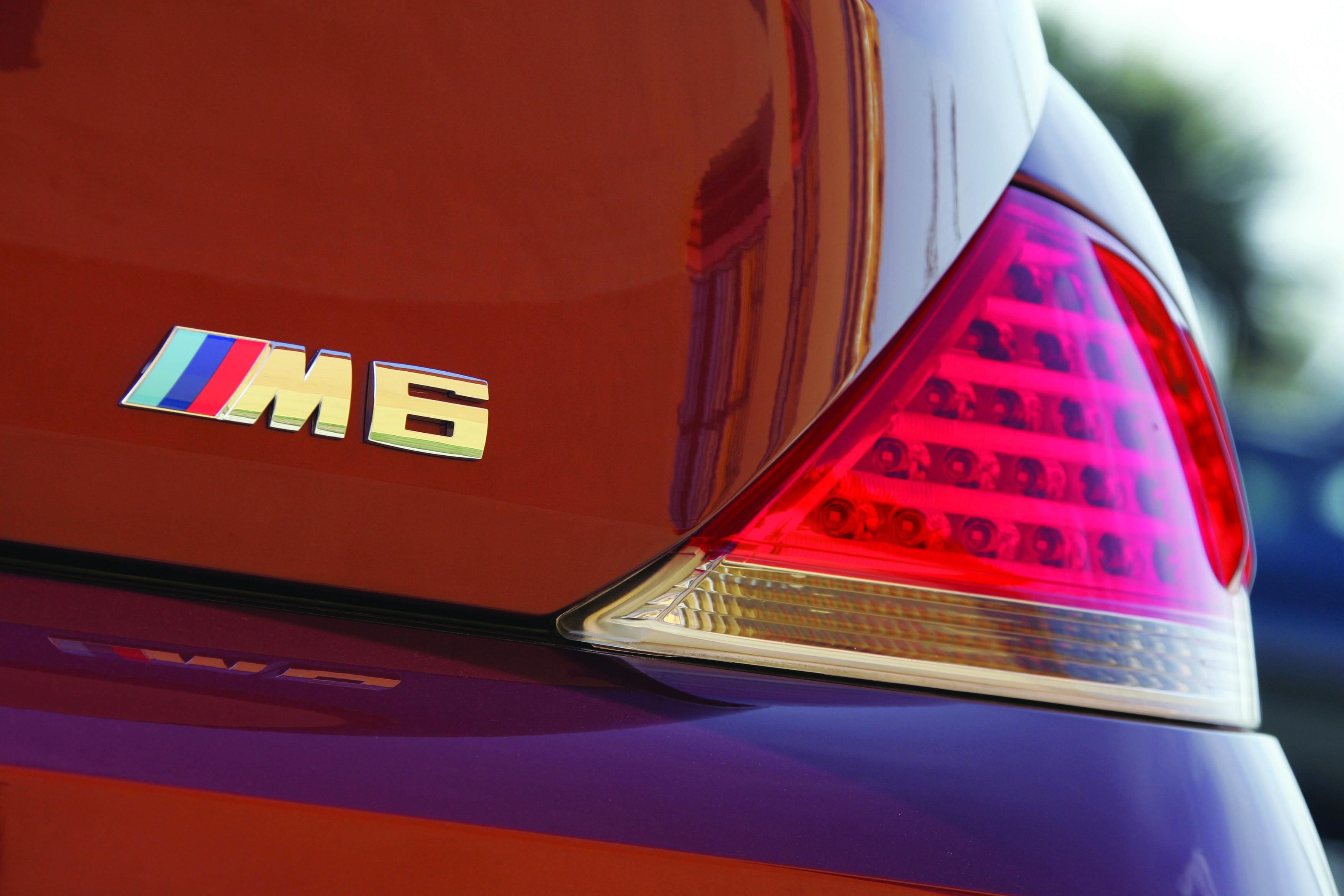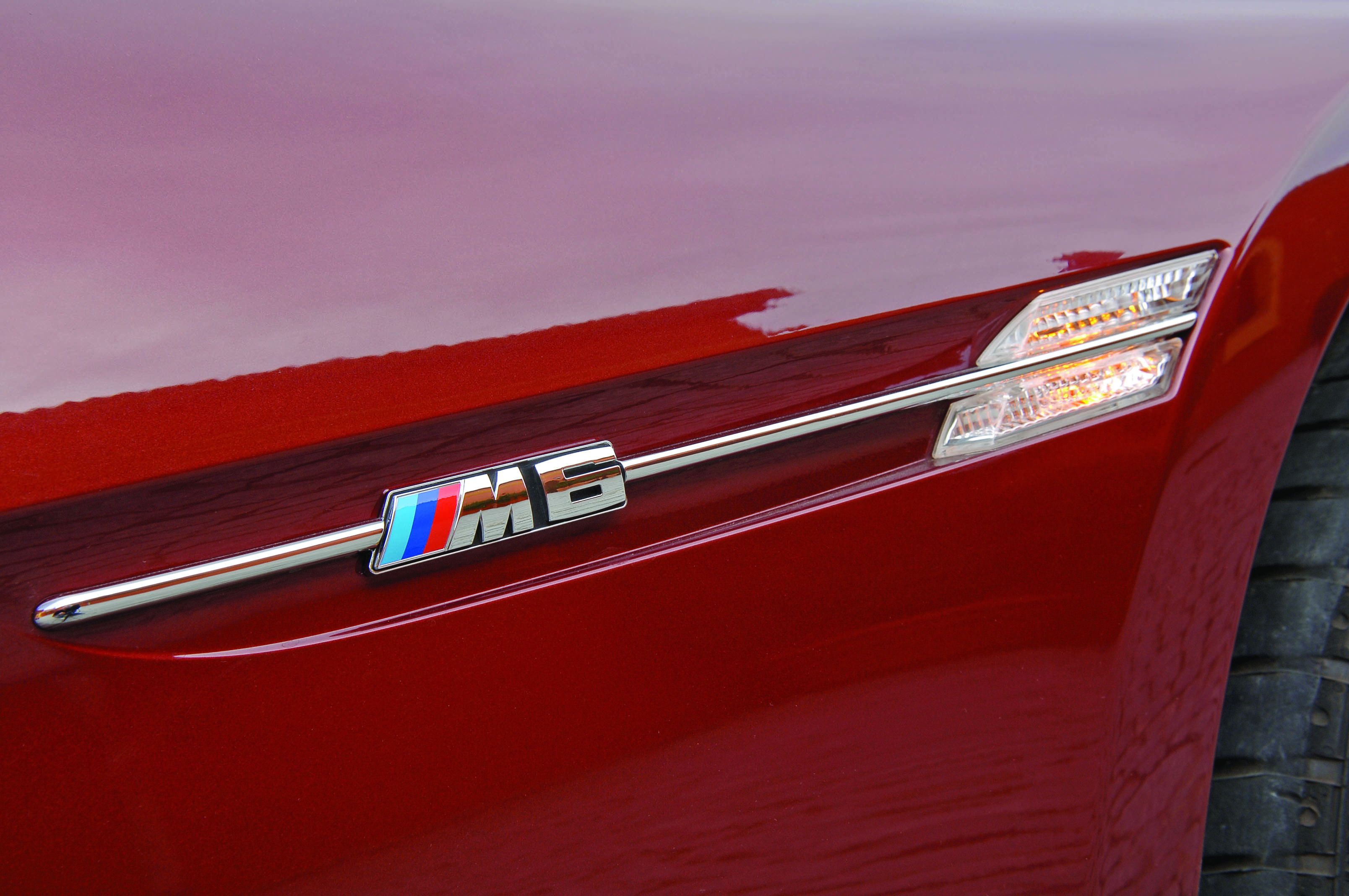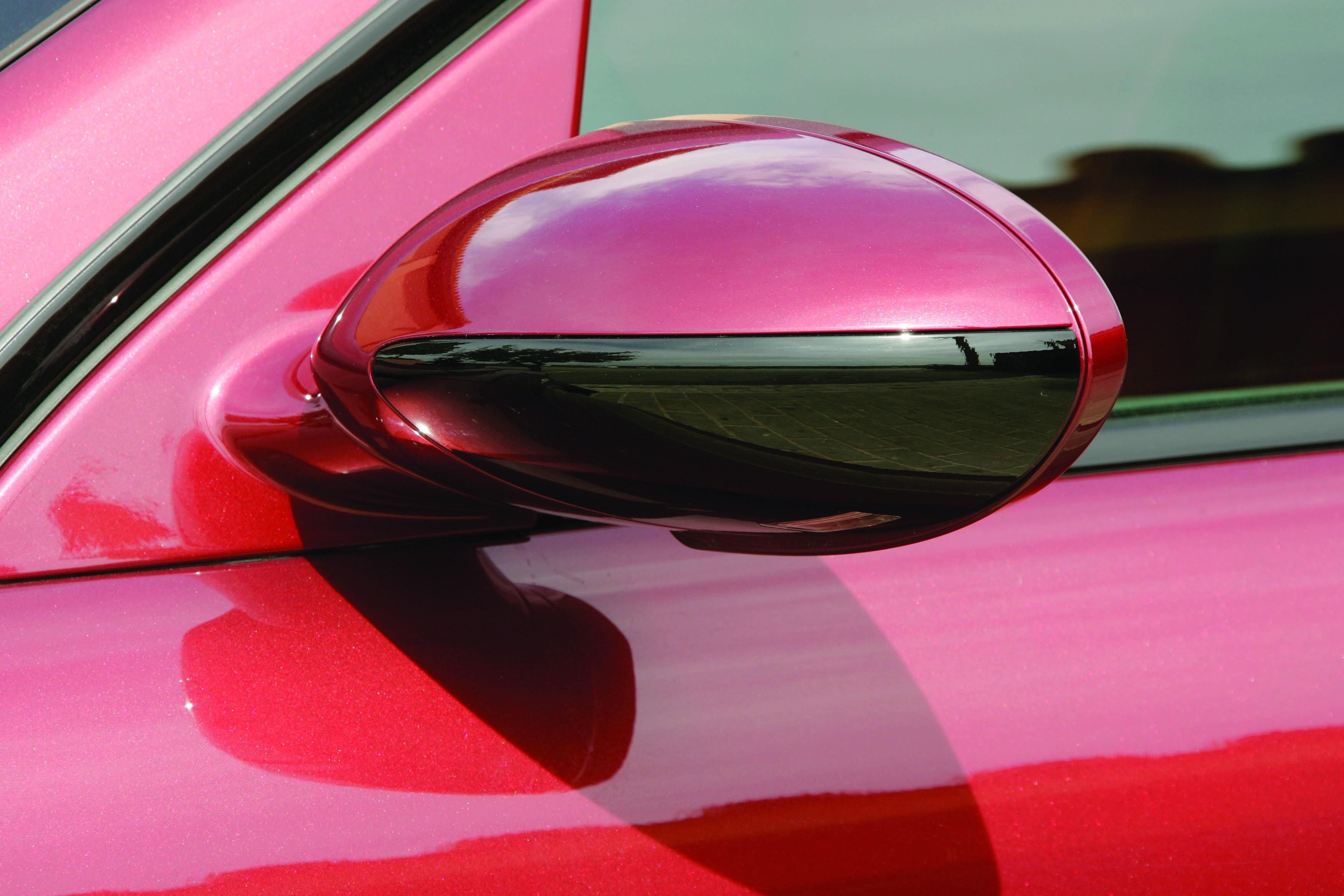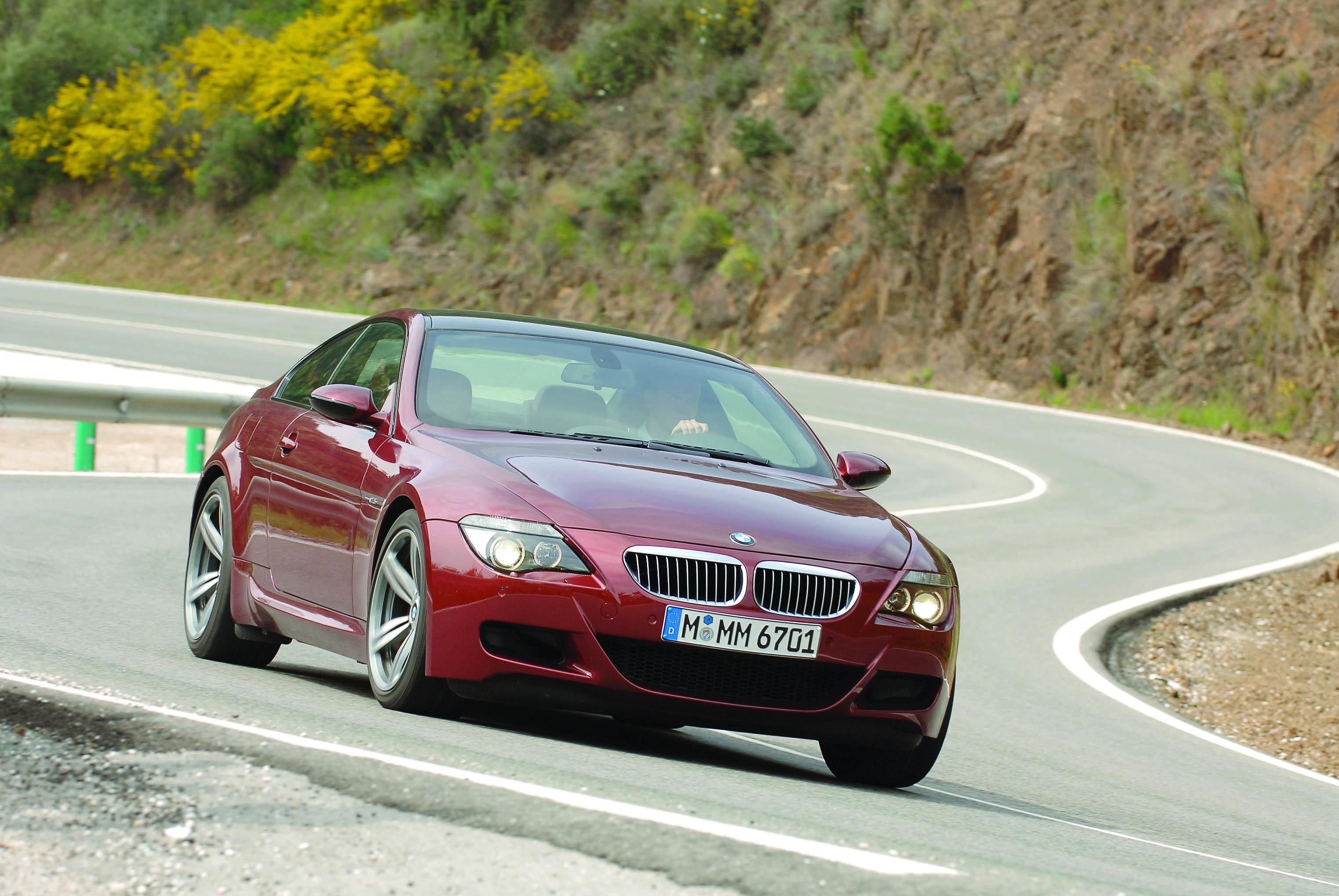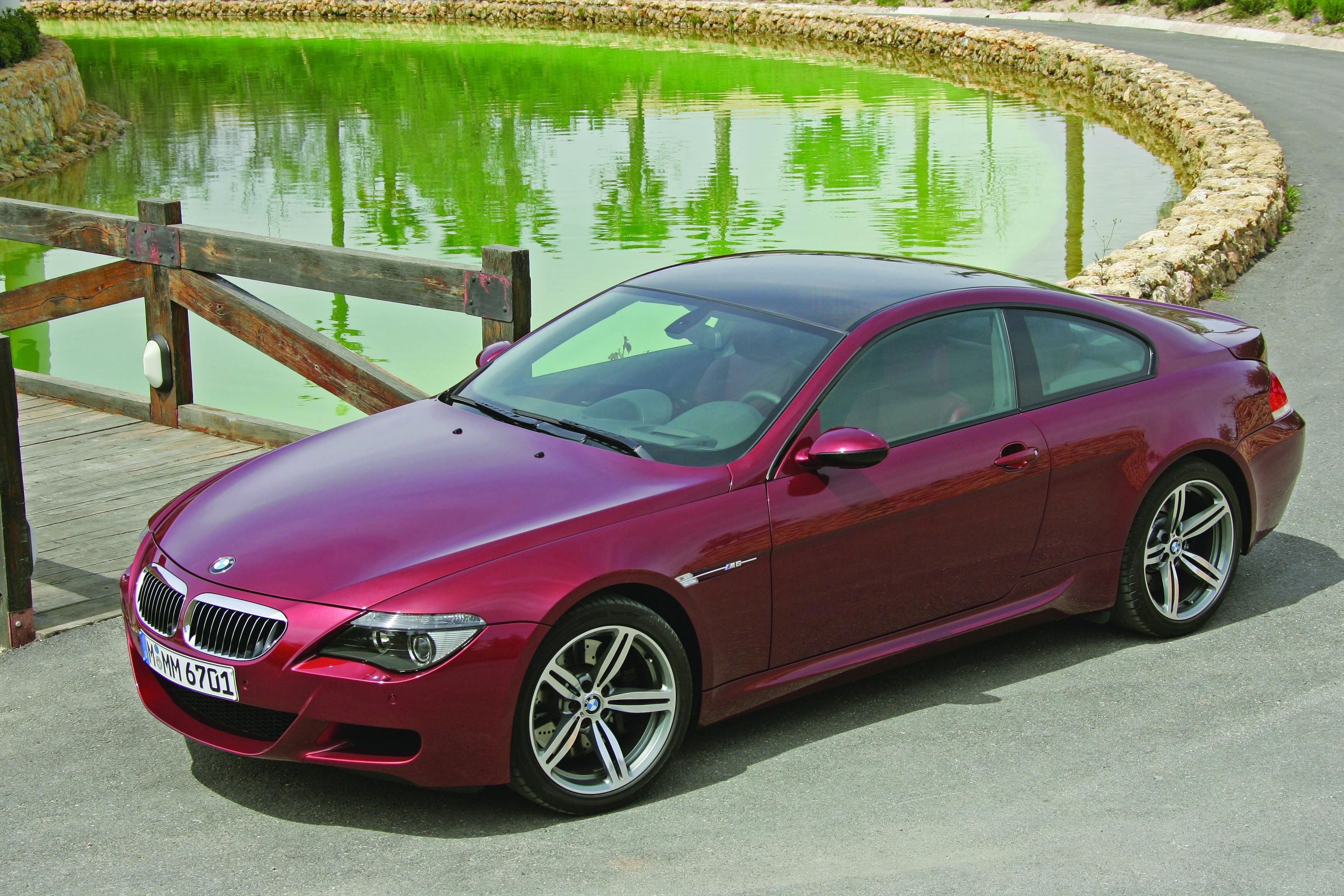Following its debut six months ago, the new BMW M5 has already made its mark, garnering raves like this from Automobile's January ‘06 All-Stars awards: “Having vanquished other sport sedans, BMW decided to make the latest M5 a supercar.“ Now, with all the power, technology and road mastery of the M5 packed into the elegantly sporty 6 Series Coupe, the new M6 makes yet another statement for BMW and BMW M: lighter and lower-built than the M5, possessed of an even sportier attitude. Customers will look at both, feel their preferences, make their choice. Either way, they get the full measure of BMW M's performance capabilities and technological sophistication. In a comparison test of these two M masterpieces, Road & Track (February ‘06) put it this way: “If you need space, the M5 is the one. For those who don't, the M6 performs ever so slightly better according to the numbers.“
2007 BMW M6
- Make: Array
- Model: 2007 BMW M6
- Horsepower: 500@7750
- Torque: 6100
- Transmission: 7-Speed manual
The new M6 has been on European roads for several months; production of the U.S. model began on March 1, 2006 in BMW’s Dingolfing, Germany plant and M6s begin appearing in U.S. BMW centers in May.
M6 vs. 650i Coupe: the BMW M treatment
Like all BMW vehicles bearing the “M“ logo, the M6 has been developed by BMW M, the BMW subsidiary for racing and high-performance automobiles. BMW M’s approach to developing its vehicles is famous, well defined and consistent; the following listing describes how the M6 differs from the 6 Series Coupe from which it is derived:
Performance & efficiency
- 5.0-liter V-10 engine – 500 hp, 383 lb-ft. torque (650i: 4.8-liter V-8, 360 hp, 360 lb-ft. torque)
- 7-speed Sequential Manual Gearbox (SMG) with DRIVELOGIC and Launch Control (650i: choice of 6-speed manual, SMG or automatic transmission)
- M Variable Differential Lock
- Specially modified and calibrated front and rear suspension
- Electronic Damping Control (EDC), specially conceived and calibrated for M6 performance/handling goals
- Special steering system: “quicker” than 6 Series, two levels of Servotronic power assist tied to EDC’s Comfort, Normal and Sport settings. Active Steering, optional on regular 6 Series models, is not available.
- Compound, cross-ventilated disc brakes – sharing with the M5 BMW’s largest-dimensioned, most powerful brakes ever – with black-painted calipers, 2-piston front calipers
- 19-in. wheels with Z-rated performance tires in differentiated front/rear sizes
- BMW M-calibrated Dynamic Stability Control (DSC) with selectable M Dynamic Mode
- MDrive (submenu in iDrive system): allows driver to combine personal preferences into a single setting, selectable via button on steering wheel:
- Three levels of engine power and throttle response
- SMG DRIVELOGIC shift-program settings
- DSC modes and de-activation
- EDC/steering settings
- Settings of available Head-Up Display (standard or M display)
Exterior design & function
- Front bumper/spoiler/air-intake ensemble
- Subtly different trim on body sides at turn-signal indicators, with M logo
- More boldly sculpted side sills/rocker panels
- Carbon-fiber roof
- Standard Satin Chrome Shadowline side-window trim
- M exterior mirrors, shaped to enhance aerodynamics and reduce wind noise
- Rear bumper/spoiler/diffusor ensemble with carbon-fiber bumper carrier
- Four round stainless steel exhaust outlets
- Four unique BMW M colors
-----
M Power to the 10th power: BMW M’s all-new V-10 engine
Once again, BMW M has blazed new trails in powertrain technology and performance. Model year 2000 saw a new V-8 engine for the then-current M5, a 5.0-liter unit developing 400 hp and thrusting that luxury sports sedan to 60 mph in 4.8 seconds. Then, in ‘01, M launched an inline 6-cylinder unit employing advanced low-mass valvetrain technology to achieve stunning high-rpm performance: With its “redline“ of 8000 rpm, this engine gave the new-generation M3 a nearly 100-hp increase from the former M3‘s 240 hp to 333 hp. This time, it’s M’s first V-10 engine for a roadgoing vehicle – introduced in the new M5 last fall and now powering the new M6 as well. In both models, it achieves essentially the same dramatic results.
Let’s begin a description of this amazing powerplant with some key data:
• 0-60 mph in 4.5 seconds
• 500 hp @ 7750 rpm, 383 lb-ft. of torque at 6100 rpm
• Redline 8250 rpm.
This new V-10, called S85 in BMW engine parlance, is yet another masterpiece of power from BMW M, setting a new milestone for the performance that can be achieved in a practical and luxurious automobile, with generous trunk space and the range of safety features one expects from BMW. So let’s look at the vital attributes of this monumental new engine, and see how they contribute to the impressive outcomes just listed.
Why 10 cylinders? Elmar Schulte, head of engine development at BMW, has a disarmingly straightforward explanation. “We wanted 5 liters. The ideal cylinder displacement is 0.5 liter. To get 5 liters, we needed 10 cylinders.”
In its general layout, the new engine relates to, and was inspired by, BMW’s Formula 1 racing engine – also a V-10. (Both engines’ major castings are done at the same BMW plant.) Though unusual, a V-10 is also a satisfactorily balanced configuration, requiring no balance shafts to make it acceptably smooth. Instead, the crankshaft incorporates two large counterweights. In its February ‘06 issue, Road & Track had this to say about it: “one of the most free-revving engines ever“…“like a Formula 1 car with mufflers. It plays such a ripplingly beautiful song up to its 8250-rpm redline that you find yourself running up and down through the gears just to hear it one more time.“
Even when idling, the V-10 sounds exotic. And, according to Automobile (July ‘05), “It sounds stunning, with a hard-edged snarl that is utterly distinctive and deeply intoxicating.“
High-rpm concept. Like the 6-cylinder M3 engine, the M6’s V-10 was conceived to exploit high engine speeds in the quest for the highest performance. Its maximum power of 500 hp is achieved at 7750 rpm, its maximum torque of 383 lb-ft. at 6100 rpm. This strategy, which avoids extreme torque and instead lets the driver extract maximum results by “revving,” allows the use of relatively light, low-mass reciprocating components inside the engine; in turn, this helps keep overall vehicle weight in check and optimize front/rear weight distribution.
Current M engines do not employ the Valvetronic system now found in BMW’s regular-production V-8 and V-12 engines as well as the new N52 6-cylinder unit in the 3, 5 and Z4 Series. Though Valvetronic eliminates throttles and their throttling effect, it is not (yet) suitable for a very high-rpm engine like this. Instead, the V-10 employs a typical BMW M valvetrain, with its 4 valves per cylinder actuated via “box-type” hydraulic lifters derived from racing practice. These are small, light and extremely rigid, as they must be for 8250 rpm; they are also specially shaped for efficient valve actuation, with an oblong cross-section (not round like bucket tappets), slightly curved contact surface and guiding tab to ensure a consistent position in their bores.
Also light in mass are the valves themselves, with stems of only 5 mm/0.2 in. And as on the new 6-cylinder, the camshafts are hollow, further reducing valvetrain inertia and enhancing engine response. Altogether, the valvetrain’s reciprocating mass has been reduced 17.5% from the former M5’s V-8 engine; this is an important facet of the high-rpm concept. So are light but ultra-strong pistons and connecting rods.
As in all recent M engines, a special High-Pressure Double VANOS system varies the intake and exhaust valves’ timing steplessly and ultra-quickly. Here the VANOS system has its own hydraulic pump; this contrasts with BMW’s regular-production engines, whose VANOS draws its pressure from the main oil pump. The resulting very high pressure (up to 115 bar/1690 lb./sq in.) enables the valve timing to be varied more quickly than on the regular engines – yet another factor in the high-rpm concept.
Four overhead camshafts actuate the valves. Each of the two intake camshafts, positioned inboard, is driven by a simplex chain; from the camshafts’ chain sprockets, the exhaust camshafts are driven by gears. The system is extremely rigid – again, as it must be for this engine’s level of rotational speed. Each chain is hydraulically tensioned and needs no periodic adjustment or replacement.
A throttle for each cylinder. Maintaining a key BMW M tradition, the V-10 has an individual, electronically controlled throttle for each cylinder.
“Breathing” – an engine’s ability to ingest and combust air – is naturally a top priority in a super-performance engine. Air is taken in at the vehicle’s front, passes through two large intake silencers and two air-mass meters, and then flows into the voluminous plenum (made of a lightweight compound material) atop the engine. From there, air passes through equal-length intake trumpets and the 10 throttles to the individual cylinders. The entire assembly of plenum and trumpets is attached to the throttle housings via a flange (one per bank) that acoustically and thermally decouples the plenum from the engine itself.
Compared to most engines’ single throttle (or even to the throttle-less Valvetronic system of contemporary BMW engines), these are a costly feature, reserved for the highest-performance engines. Positioned much nearer the cylinders than a single throttle can be, they eliminate a “lag time” inherent in airflow and foster lightning-fast response to throttle movements. Motor Trend characterized this engine’s throttle response as “blazingly urgent.”
Actuation of the throttles is electrically driven and electronically controlled. Each cylinder bank’s five throttles are actuated from a single shaft. Via the accelerator pedal, the driver gives the commands. In turn, these commands are processed by the engine control module and received by a DC servo motor (also one per cylinder bank). The motor drives the throttle shaft through a tiny gearbox.
Via the MDrive system (described later), the engine’s maximum power and the throttles’ response to the accelerator pedal can be set to different levels; see MDrive.
Ultra-high compression ratio. At 12.0:1, the V-10 notches up BMW’s highest current compression ratio. The higher the compression ratio, the more power can be extracted from a given engine size, so: another factor in the V-10’s performance.
Ionic-current technology. In a “world first” for such a high-revving engine, and a first for BMW, BMW M’s engineers have applied an exotic technology to the knock control that is crucial with such a high compression ratio. Instead of piezoelectric knock sensors positioned in the cylinder block to detect detonation via sound-pressure level, the sparkplugs themselves do the knock-sensing – and do it incredibly quickly and directly.
The air-fuel mixture in an engine’s cylinders has a certain electrical conductivity, which varies – especially as “knock,” or detonation, occurs in a cylinder. Built into the engine’s electronics is circuitry that applies a small voltage across the sparkplug’s electrodes just after it fires; the resulting ionic current is a function of the combustion process taking place. If knock (detonation) is incipient, the ionic current will so indicate; a signal goes to the engine’s electronic control system and ignition timing is retarded appropriately.
In all BMW knock-control strategies, each cylinder’s combustion process is measured individually; if only one cylinder is tending to knock, only that cylinder will have its ignition timing retarded. The advantages of this technology over conventional block-mounted knock sensors are
- Ignition adjustment occurs more quickly. The whole process – onset of knock, measurement of ionic current, adjustment of timing – takes place in just 0.8 milliseconds at 8000 rpm, rapid enough to adjust the timing before that sparkplug’s next firing.
- Because of its extreme sensitivity and speed, this technology allows the engine to “edge closer” to its full potential in the upper reaches of power and rpm.
- Helps control fuel consumption and exhaust emissions.
Ionic-current technology does not require a different type of sparkplug, nor is the sparkplug’s durability affected by its extra “duty.” The current-measuring voltage is only about 100 volts, vs. more than 25,000 V applied to fire the sparkplug.
Weight-efficient construction. The V-10 engine is of aluminum, with bedplate construction for the lower portion of the cylinder block. This construction is inherently ultra-rigid; for the strength to withstand the massive internal forces of this engine, however, the main-bearing inserts are of cast iron. Sharing a major feature of most current BMW engines – N52 6-cylinder as well as all V-8s and V-12 – the cylinders are silicon-impregnated, with “soft honing” removing just enough of the aluminum to leave the silicon crystals as ultra-hard cylinder surfaces.
The entire engine weighs just 240 kg/529 lb. – almost exactly the same as the prior M5 V-8 engine, yet the V-10 delivers fully 106 hp more output!
G-sensitive lubrication system. Given the 45˚ cant of the cylinder banks and the M6’s cornering ability, special attention has been directed to ensuring natural return of oil to the main sump. There are two sumps, the main and larger one behind the front frame crossmember and a smaller one forward of the member; a baffle separates the two from each other in this “semi-dry-sump” system.
First, the mechanically driven main oil pump is newly of the variable-volume type, an innovation also found on the new 6-cylinder engine. By varying the output of its pump element according to engine oil pressure, the engineers have achieved a pump that always delivers sufficient pressure to lubricate this demanding engine, yet never pumps more oil than is necessary. Thus it –
- Contributes to the high power output, by requiring less power from the engine.
- Doesn’t require a bypass to divert excess flow; this helps avoid excess oil temperatures and oil foaming.
There is also a recirculating pump that picks up oil from the small front oil sump and transfers it back to the main sump. Additionally, there is an electrically driven scavenging pump for each cylinder bank. In straight-ahead driving, these pumps pick up oil from the rear of the engine and return it to the sump. In hard cornering (0.6g or greater), the Dynamic Stability Control system’s lateral-g sensor switches magnetic valves to different pickup points, at the curve-outer side of either head and the oil pan. This system remains active even if the driver switches off DSC.
The oil level and temperature are monitored by a thermal sensor; a warning is displayed if the level falls low, and an oil-temperature gauge is included in the tachometer face. Oil is cooled by a coolant-oil heat exchanger.
Low-back-pressure, tuned exhaust system. Exiting the engine through stainless steel exhaust headers that Germany’s auto motor und sport magazine (November 10, ’04) called “an artwork in stainless steel,” exhaust gas from each cylinder travels an ideal length of 560 mm/22 in. before reaching the engine-close first catalytic converter on each side. A high-pressure forming technique is used to shape the headers, enabling them to achieve the necessary strength and desirable light weight with only 0.8-mm/0.03-in. wall thickness. Two additional catalytic converters, one per side, are located farther back in the system.
Further advanced engine electronics. Once again BMW M has developed a new, ultra-powerful electronic control system; called MS S65, this scheme incorporates much of the experience gained from the V-10 racing engine. All the engine’s electronic functions – throttles, ignition, fuel injection, lubrication, dialog with the Sequential Manual Gearbox, and more – are overseen by a central electronic module employing three 32-bit microprocessors capable of 200 million operations per second.
This system also incorporates the MDrive functions, including the three power levels and throttle calibrations described under MDrive.
Variable tachometer warning zone. Pioneered on the previous M5 engine and now found on 5, 6 and 7 Series as well as M3 and Z4 M Roadster tachometers as well, this feature reminds drivers that a cold engine should be treated with care. Displaying a yellow “caution” segment and a red “limit” segment, this zone moves from a minimum point with a cold engine to the full 8250-rpm redline as the engine oil warms up.
-----
7-speed Sequential Manual Gearbox:advanced technology for optimum performance}0}
Initially, the M6 is offered exclusively with this unique SMG transmission, which employs Formula 1 racing technology to help drivers extract the M5’s full performance potential. For M6 customers who prefer a conventional manual transmission, a 6-speed will be offered later.
This amazing new system does everything a manual transmission can do, plus several things a manual can’t:
- Offers 7 forward gears, which would be awkward for a manual shift lever to manage.
- In high-performance driving, can shift much faster than even an expert driver.
- Can provide automated shifting when desired.
- Offers a wide variety of shift programs in Automated and Sequential modes.
- Engages and disengages the twin-disc clutch, precisely coordinating its action with shifts. There is no clutch pedal.
This is the first SMG designed and developed right from the start as an SMG; Two BMW M generations and the simpler system offered in regular-production BMWs were created by adding SMG controls to a conventional manual transmission. This has sweeping implications for how the concept operates and what it can do:
- The gears are positioned in so that the gearsets with the greatest loads (1st, 2nd and 3rd) are closest to the load-carrying bearings. This promotes durability in a transmission that must transmit immense power and is shifted fast and hard.
- To be shifted by a conventional shift lever, this gearset placement would result in an extremely awkward shift pattern. But this was not a problem, because all shifting would be executed the SMG way.
- Even if the shift pattern were manageable, 7 speeds would be difficult for a driver to manage; a 6-speed is the practical limit for a purely manual transmission.
- And yet with a high-revving, high-performance engine, 7 speeds are ideal and desirable, tangibly helping the driver extract such an engine’s full potential.
- The entire internal mechanism – gears, shafts, bearings, shift rods – could be laid out optimally for SMG’s electrohydraulically powered shifting; it is in no way compromised to allow conventional manual shifting.
- The mechanism allows simultaneous actuation of two shift rods at once, which helps the unit achieve lightning-quick shifts. Additionally, the gear synchronizers utilize carbon-fiber cones, which also contribute to the ability to shift so fast.
DRIVELOGIC shift programs, 11 of them. In this respect, the new transmission parallels BMW M’s 6-speed SMG, offered on M3s since 2002. There are two basic shift modes: Sequential (S), in which most shifting is initiated by the driver; and Automated (D, for Drive), in which operation is similar – but by no means identical – to that of a automatic transmission.
Within these two modes, there are as before a total of 11 shift programs:
- Sequential – 6 programs, S1-S6 from “softest and slowest” to “hardest and quickest” shifts; i.e. from most leisurely to sportiest. The driver initiates shifts with either the console shift lever (tip forward for downshifts, rearward for upshifts) or “paddles” on the steering wheel (left paddle for downshifts, right for upshifts).
- Automated – 5 programs, D1-D5 similarly from mildest to sportiest, with the distinction that as the program gets sportier, the speeds at which shifts occur also move upward. Even in this D mode, if the driver manually initiates a shift, the unit switches to S and remains there until D is again selected by the driver.
In S6, the sportiest program of all, minimum shift time is reduced 20% from the existing SMG – already very fast. In everyday driving, shifts are now smoother.
As in the existing SMG, gears are shifted electrohydraulically; shifting is controlled by a 16-bit microprocessor that can make up to 12 million calculations per second.
Special functions and safeguards. The 7-speed SMG incorporates a number of special functions and safeguards, some familiar and some new:
Launch Control. In S6, the driver can utilize a further SMG capability. Dynamic Stability Control must be de-activated via its console button. Then the driver holds the shift lever forward (as if for a downshift) and presses the accelerator pedal fully down. This raises the engine to 1600 rpm. Ready to go, the driver now releases the shift lever. Engine speed rises immediately to 8000 rpm; the M6 launches with precisely balanced clutch slip and wheelspin for an optimum start. From there, the driver upshifts as desired – most likely at the redline, as maximum performance is the point of the exercise. Thus utilized, Launch Control gives essentially the same standing-start acceleration results as an expert driver. To preclude overheating the clutch, the system requires several minutes between Launch Control starts.
Automatic downshift to 1st gear for starting off from rest, whether in D or S mode. If the mode selector is in D, upshifts will then occur automatically; or the driver can initiate the upshifts.
Overspeed protection. If the driver calls for a downshift (S mode) that would overspeed the engine, the downshift command is ignored.
Slip Control. If a downshift occurs on a slippery road, SMG disengages the clutch for a split second to prevent sudden wheel slip that could de-stabilize the vehicle.
Start-off Assistant. When stopped facing uphill, the driver simply holds the brake pedal until ready to start off. Upon release of the brakes, the M5 is ready (for 1 second) to start off without rolling back.
Hill Detection. Depending on road gradient, down- or uphill, the D shift points are modified for optimum gear selection. In S, shift times are shortened so that the engine is always “on point” for best acceleration uphill, or engine braking downhill.
Double-clutching. In D or S mode, DRIVELOGIC coordinates clutch disengagement, shifting, engine speed and clutch engagement to accomplish smooth downshifts – just as a skilled driver would.
2nd-gear start in D1 program: Starting up from rest, the transmission is in 2nd rather than 1st; the clutch engages delicately. Although the traction-control function is also there to prevent it, this reduces the chance of even transitory wheelspin.
-----
M6 suspension: targeted modifications}0}
Changes from the regular-production 650i Coupe affect the suspension system and its connections to the body structure; a special M version of Electronic Damping Control; the M Variable Differential Lock; Servotronic steering with two levels of power assist; amply dimensioned, cross-drilled brakes; and wheels and tires that give the M6 an awesome footprint.
Start with suspension hardware, already an advanced all-aluminum system on the 6 Series. (The vehicle’s frontal structure too is aluminum, helping contain overall weight and contributing to near-perfect front/rear weight distribution.)
At the front, modifications include the subframe and thrust plate (both still aluminum), fine-tuning of geometry, more rigid bushings and a 0.4-in. wider track. At the rear, the changes are more extensive:
- The subframe is modified.
- Suspension links are essentially the same as in the Z8.
- Bushings are stiffer.
- Axle halfshafts are hollow for reduced weight with greater strength.
- Geometry
Changes from the regular-production 650i Coupe affect the suspension system and its connections to the body structure; a special M version of Electronic Damping Control; the M Variable Differential Lock; Servotronic steering with two levels of power assist; amply dimensioned, cross-drilled brakes; and wheels and tires that give the M6 an awesome footprint.
Start with suspension hardware, already an advanced all-aluminum system on the 6 Series. (The vehicle’s frontal structure too is aluminum, helping contain overall weight and contributing to near-perfect front/rear weight distribution.)
At the front, modifications include the subframe and thrust plate (both still aluminum), fine-tuning of geometry, more rigid bushings and a 0.4-in. wider track. At the rear, the changes are more extensive:
- The subframe is modified.
- Suspension links are essentially the same as in the Z8.
- Bushings are stiffer.
- Axle halfshafts are hollow for reduced weight with greater strength.
- Geometry
Here the track is actually narrower (by 0.4 in.) than that of a 6 Series with standard wheels, because the 285/35 rear wheels’ center plane must be farther inboard for their massive tires to clear the bodywork. But the actual footprint is wider.
And at all four wheels, specially calibrated springs and shock absorbers – the latter made variable by Electronic Damping Control, next – complete a sporting chassis that only BMW M could create.
M Electronic Damping Control
Already offered in the 7 Series but not in U.S. 6 Series or other M models, EDC steplessly controls the shock absorbers to any level between softest and firmest, precisely adapting to road conditions and the driver’s demands at any given moment:
- Ride firmness is always optimum for current road conditions, vehicle speed and vehicle loading (passengers and luggage).
- On smooth roads, the shock absorbers are kept at the softest appropriate setting (considering the character of the vehicle) for riding comfort.
- When the vehicle is rounding a sharp corner or curve, the shock absorbers are automatically and instantly adjusted to a firmer, just-right level.
- On any irregular road surface, the shocks automatically and instantly adjust to the optimum level of firmness to control ride motions, preserve riding comfort and maintain adhesion to the road.
- Basic system advantages are calibrated to M Car character.
On the M6, there are three modes rather than the two of the luxury-oriented 7 Series EDC. Selected via the EDC console button or MDrive menu, they are –
- Normal, likely to be chosen most of the time; a judicious blend of M-style handling precision and riding comfort.
- Comfort, shifting the balance toward riding comfort. Appropriate for gentle, speed-controlled driving on relatively smooth and straight roads.
- Sport, putting top priority on the M6’s tremendous road capabilities at some sacrifice of riding comfort.
Within each mode, EDC continuously adjusts shock-absorber firmness to actual conditions.
Of the M6’s overall road prowess, Switzerland’s authoritative Automobil Revue reported in its April 20, ‘05 issue: “The elaborately engineered suspension makes for tenacious roadholding and allows enormously high cornering speeds. The M6 exhibits neutral handling, combined with direct and precise power steering.”
M Variable Differential Lock: putting power to the road, the BMW M way
Mechanical limited-slip differentials belong to BMW M’s tradition of ultimate road handling. Together with the German division of GKN Viscodrive, BMW M engineers developed a more capable mechanical limited-slip differential; called the M Variable Differential Lock, the concept appeared first on the M3, then the M5; now it comes to the M6 as well.
Under dry to not-quite-dry road conditions, the traditional 25% limited-slip has some ability to improve traction; but under split-traction conditions (one wheel on slippery, the other on firmer ground) it cannot transmit more torque than the slippery side permits. On all current BMW models, electronic traction control (a function of Dynamic Stability Control) addresses this issue, though not optimally for sporty driving in the M Car sense. (Thus there’s a switch to reduce or altogether eliminate DSC action when the driver so desires.)
The M Variable Differential Lock specifically addresses low- and split-traction situations in a way that reinforces sporty handling, imparting a slippery-road ability other high-performance, rear-wheel-drive sports cars generally do not have. The main distinction between a traditional limited-slip “diff” and the M Variable Differential Lock is that where the former senses torque, the latter senses wheel speed.
Anytime a speed (rpm) difference develops between the two rear (driven) wheels, a shear pump, driven by this difference, develops pressure in the unit’s silicon viscous fluid. This pressure is applied to a multi-disc clutch that transfers driving torque to the wheel with the better road grip (this priority is called “select high”). The greater the speed difference between the two wheels, the more aggressively the clutch engages. As this wheel-speed difference diminishes, the clutch begins to ease off.
This mechanism accomplishes finely calibrated action by entirely natural means. There is no external pump, no external source of lubrication or operating fluid. The very motion to be controlled – differences in speed between one wheel and the other – generates its locking action.
-----
Servotronic steering with two effort levels
Like the ’06 7, 6 and 5 Series, the M6’s rack-and-pinion steering system has Servotronic vehicle-speed-sensitive power assist.
Also, the steering ratio – the number of degrees the steering wheel must be turned to steer the front wheels by 1 degree – is variable; the ratio gradually becomes “quicker” (greater steering angle relative to steering-wheel turns) as the steering wheel is turned away from its center position. This is not BMW’s Active Steering, which varies the steering ratio more widely and does so in response to vehicle speed; instead, BMW M chose to tailor the 6 Series’ “standard” steering system to the attributes of this ultimate sports coupe.
But variable ratio and Servotronic assist aren’t all that’s special. The M6 also offers the driver a choice of two levels of assist: Comfort, with typical BMW assist, and Sport, with less assist for sportier feel. Within these two settings, Servotronic varies the assist according to vehicle speed.
Immensely powerful, fade-resistant compound, cross-drilled brakes
To match its colossal performance, the M6 gets immensely dimensioned ventilated disc brakes. At the front, they are 374 mm/14.7 in. in diameter and 36 mm/1.42 in. thick, compared with the 650i’s already generous 348 x 30 mm. At the rear, they’re 370 mm/14.6 in. in diameter and 24 mm/0.94 in. thick (650i: 345 x 24). But the M6 goes further, with compound brakes.
This most elaborate of BMW brake concepts, also appearing on the M3 with Competition Package and the M5, shares 2-piece rotors with the 6 Series: an aluminum “hat” inner portion to reduce unsprung weight, and a cast-iron outer portion as the actual friction surface). But whereas on those models the hat and outer portion are riveted together, here the hat and outer portion are connected by steel pins on which the aluminum and cast-iron portions, because of their differing expansion rates, can move relative to each other.
The 6 Series’ aluminum/cast-iron rotors cut unsprung weight, and reduce rotor deformation under hard-braking, high-heat conditions by about 20%. This construction is more elaborate and costlier. It saves an equal weight proportion, and totally eliminates deformation. This means virtually no tendency of the brakes to vibrate when red-hot, and virtually no likelihood of the rotors cracking even under the extreme temperatures that might be encountered in driving on a racetrack.
Additionally, the M6 brake rotors – again, as on the M3 Coupe with Competition Package and the M5 – are cross-drilled to enhance heat dissipation beyond that provided by the rotors’ internal ventilation; this further enhances fade resistance. It also reduces weight – unsprung weight – by a full 1.5 kg/3.3 lb. per rotor. The front calipers have dual pistons, another M6 upgrade; front and rear calipers – highly visible through the wheels – are finished in glossy black.
Thus the M6 incorporates BMW’s most capable braking system. It is one of the many reasons why the M6 is a truly track-ready car.
Wheels and tires: ultimate grip and style
In its wheel-tire equipment, the M6 takes the 6 Series platform to its ultimate level of performance and style. The wheels, in a very open, discreetly aggressive M Double Spoke design, are sized 19 x 8.5 front/19 x 9.5 rear and carry 255/40ZR-19 front / 285/35ZR-19 high-performance tires , specially developed for the M5 and M6. Though both are designated M Double Spoke, the actual wheel designs differ: the M5 has 10 double spokes, the M6 five.
These are not run-flat tires; there are no run-flats yet that meet BMW M parameters of speed rating and weight. The regular-production 6 Series does come with run-flats and has no provision for a spare tire, so the M6 is equipped with the M Mobility System.
If a tire is punctured – a rare event in any case – the M Mobility System provides for temporary repair and inflation of the damaged tire. Should a tire ever be completely destroyed, BMW Roadside Assistance is available for the life of the vehicle.
Specially calibrated, variable Dynamic Stability Control
DSC is standard on all BMW models; on all current M models, this electronic traction and stability system complements the M Variable Differential Lock.
DSC optimizes traction by electronic means. In cooperation with supplier Continental Teves, BMW M engineers have developed specific DSC logic that, together with the fast-responding engine, performance-oriented gearing and differential lock, achieves traction enhancement in an M-compatible way…in other words, without undue interference with M6 performance and the differential lock’s ability to get M power to the road. With M-calibrated DSC and the differential lock at work, the M6 can master virtually any traction situation.
The M6’s DSC also includes some new functions recently added to other Series:
- Brake Standby. When the driver lifts off the throttle pedal abruptly, DSC senses that sharp braking may be about to occur and applies just enough pressure to snug up the pads against the rotors. Thus by the time the driver’s foot reaches the brake pedal, the short lag from bringing the pad to the rotor is eliminated; this can reduce the stopping or deceleration distance.
- Brake Drying. Acting on input from the windshield wipers’ rain sensor, the pads are periodically brought up to the rotors – just enough to eliminate any film of water between pads and rotors, but not enough to cause any brake application.
As usual, DSC can be de-activated by the driver. Like the M5, the M6 DSC takes on a unique dimension by offering an M Dynamic Mode. Activated by the DSC console button, this mode allows more oversteer and wheelspin, useful to an expert driver on a race track. It is not recommended for use on public roads.
-----
MDrive: M technology at the driver’s disposal
Via the MDrive system, the driver has fully 279 combinations of control settings to choose from – and an MDrive button on the steering wheel that allows 1-touch selection of the driver’s preferred combination of same. Here’s how it all works:
Power and throttle response. Three settings: P400, the default mode, allows a maximum of 400 hp and gives “normal” throttle response. P500, the “normal performance” setting, allows full maximum output of 500 hp, with quicker throttle response. Both these settings may be selected conveniently via the Power button on the console, next to the shift lever.
The third setting, P500 Sport, also allows full engine power, but provides even quicker throttle response. It is selectable only in the MDrive menu on iDrive.
Transmission. SMG provides 5 automated programs in Drive, D1-D5; 6 programs in Sequential, S1-S6.
Electronic Damping Control. Normal, Comfort and Sport settings. Steering assist is linked to these: Its Comfort mode (more assist) goes only with EDC’s Comfort setting. The steering’s Sport mode (less assist) goes with EDC’s Normal and Sport.
Dynamic Stability Control. Three settings: Normal, M Dynamic Mode and de-activated (though ABS always remains active).
How does MDrive arrives at those 279 combinations? 3 power settings x 10 SMG programs (excluding for the moment S6) x 3 EDC modes x 3 DSC choices = 270. Then, transmission program S6: Because it can be selected only with DSC deactivated, 3 power settings x 3 EDC modes = 9. Add these to 270 and you get the full 279 modes. One might even see the total as 280 by counting Launch Control – itself accessible within S6 – as a further program.
Selecting modes in MDrive. Within the MDrive menu, the driver can select every one of these settings and link them to the MDrive button on the steering wheel. Then, regardless of which individual settings have been selected previously, all these choices are instantly set to what the driver has programmed in MDrive. Conversely, the previous settings will be restored when the MDrive button is pressed again.
Power settings P400 and P500 can be summoned by pressing the appropriate button on the console. So can the EDC and DSC modes; likewise the SMG program, which can be set via the shift lever and the mode selector behind it.
Additional MDrive settings. Two optional features – the M Head-up Display and the M Multi-function sport seats’ Active Seat Backrests – can also have their settings programmed onto the MDrive button via the MDrive menu.
Abundant luxury accompanies definitive performance
The 6 Series interior presents luxurious, ergonomically engineered 2+2 accommodations for its driver and passengers. In an atmosphere of tasteful design and high-caliber materials, typical BMW attention to instrumentation and controls supports attentive, yet relaxed driving and pleasant, comfortable riding. To this elegant space, BMW M adds its heightened emphasis on performance driving and even more sumptuous materials.
Special M instrumentation
Both main instruments have unique fulltime-illuminated white scales and red pointers. The speedometer scale reads to 200 mph, the tachometer to 9000 rpm.
With such a high-performance engine, oil temperature is a critical factor – and the one to which the variable rpm limit is calibrated. Accordingly, an oil-temperature gauge is set into the lower portion of the tachometer. As a further distinction of M6 instrumentation, via the On-board Computer the driver can select oil temperature (instead of average speed) to be shown in the instrument-cluster display.
M sport steering wheel
The M6’s power tilt/telescopically adjustable steering wheel is sized, proportioned and designed to be “as sporty as it gets.” Its distinctions include:
- Thick rim, padded leather with M-color stitching
- Thumb contours at 10 and 2 o’clock
- SMG paddles above lateral spoke: right for upshift, left for downshift; “+“ and “-” markings illuminated at night
- MDrive button replaces one of the 6 Series’ programmable buttons.
Merino leather, Extended or Full treatments
BMW’s finest leather grade, Merino, is available in two versions and with unique M colors making up most of the palette.
Standard equipment is an Extended treatment of Merino leather, with this beautiful leather appearing not only on the seats, head restraints and door panels, but also the center armrest. In the optional Full treatment, leather is applied to expanded seat, door and console areas as well as extensive portions of the dash. The color selection is:
- Extended Merino leather – Black, Silverstone II and Sepang Bronze Light
- Full Merino leather – Black, Portland Brown, Sepang Bronze Light, Silverstone II and Indianapolis Red.
In all M6 interiors, the headliner and roof pillars are in Anthracite color; with Full leather, they are in luxuriant Alcantara material.
Special interior trim
With the Extended leather upholstery, the standard interior trim – appearing across the dash and on the door pulls – is Walnut Madeira wood, which is reddish brown and has a relatively linear grain. Optional are:
- Olive Carrara Natural, a medium-tone wood with burl grain
- Carbon Fiber Black, matching the carbon-fiber roof panel.
Walnut Madeira is standard with all Full leather treatments; Olive Carrara and Carbon Fiber are available with certain interior colors.
M sport seats
BMW M sport seats embody comprehensive design and features for supporting the driver in sporting driving.
The standard M front sport seats include power-adjustable backrest width, which enhances their adaptability to various human statures; power 4-way lumbar support; manually adjustable thigh support; and 3-stage heating. Along with the steering wheel and exterior mirrors, each driver’s preferred position adjustments are stored in Vehicle & Key Memory and are reset to those adjustments when that driver unlocks the vehicle with his or her remote.
Navigation System and premium audio system, standard
BMW pioneered the installation of GPS Navigation in motor vehicles; the BMW On-board Navigation System has been developed continually to enhance its user-friendliness as well as its scope of functions. This system is standard in the M6; in brief summary, its features include –
- GPS Navigation System with DVD database
- High-resolution (640 x 240 pixels), 8.8-in. Control Display
- Controller with Force Feedback (incorporates tactile feedback into controller movements)
- Voice Command of numerous features and functions.
BMW’s acclaimed Logic7 audio system, also standard in the M6, includes –
- Abundant audio power
- Very high-caliber speakers (aluminum-membrane type for all but subwoofers); 13 speakers, including 2 subwoofers
- Digital Sound Processing (DSP), adjusted along with other Logic7 parameters on iDrive Control Display
- Surround Sound simulation
- 6-disc CD changer, accessed through the glove compartment.
Safety and security features: comprehensive engineering and equipment
In terms of safety and security, the M6 – along with the 6 Series – is a state-of-the-art vehicle from a state-of-the-art vehicle maker. Key features include –
- Dual front-impact Supplementary Restraint System (SRS) with dual-threshold deployment of 2-stage Smart Airbags that are optimized for shape and deployment characteristics.
- Advanced seat-occupant detection on front passenger’s seat.
- Front safety belts with automatic tensioners and force limiters – standard.
- LATCH attachments for child restraint seats at the rear seating positions.
- Active Knee Protection – Two dedicated airbags, positioned underdash ahead of the driver’s and passenger’s knees, provide knee protection primarily in frontal impacts. Because they are normally in an uninflated state and inflate only when actually needed, they free up space in the footwell area.
- Interlocking door anchoring system for side impacts.
- Front-seat side-impact airbags – door-mounted.
- Head Protection System – head protection for front-seat occupants via a tubular airbag that deploys from ceiling and is suspended on a “sail.”
- Energy-absorbing padding of body-pillar and roof areas – at the A-, B- and C-pillars as well as along the roof above the doors.
- Fuel-tank design and location. The fuel tank is designed to remain sealed in severe impacts; its location was chosen for optimum protection from impacts.
- Advanced Crash Safety Management System (ACSM) – employing 14 sensors to achieve a precise “tailoring” of safety devices’ deployment to actual accident circumstances.
- Battery Safety Terminal – in case of a severe accident impact, breaks the high-current connection between the battery and starter cable. This helps prevent a possible short circuit in the electrical system.
- Automatic fuel-pump shutoff upon severe accident impact. The doors are automatically unlocked; interior lighting and 4-way hazard flashers are switched on. Even after an accident, BMW’s safety strategy is still at work.
- Coded Driveaway Protection – The multi-function remote is equipped with a tiny transponder which stores an electronic code transmitted by an antenna at the ignition slot. Each time the remote is removed, this code is changed; the next time, the engine can be started only if the remote matches the new code.
- Central locking system with double-lock feature. When the vehicle is locked from the outside, the double-lock feature prevents individual door-lock buttons from being pulled up; thus even if a thief has broken into the car, it isn’t possible to open the doors.
- Alarm system with interior motion detector – standard.
- BMW Assist – BMW’s comprehensive system of customer services and in-car telematics is standard. Includes a 1-year subscription to the BMW Assist Safety Plan, after which the customer pays an annual subscription fee.
Options: almost everything is standard
Because the M6’s standard equipment is so extensive, its options list is relatively short. Yet certain features are optional, some unique to the M6.
Comfort Access. Eliminates the need to activate a remote to unlock or lock the vehicle, or to insert it into the dash slot before starting the engine:
- Vehicle access – User enters vehicle merely by pulling a door handle, or opens the trunk by pressing the trunk release. Presence of the remote (say, as in the user’s pocket or purse) has confirmed that the user is authorized.
- Starting – User authorization is confirmed by the presence of the remote inside the vehicle; the driver starts the engine by merely pressing the Start/Stop button.
- Engine switch-off and vehicle locking – Driver turns off engine via Start/Stop switch, and presses a door handle to lock the vehicle after exiting.
If the user has left the remote in the interior, the vehicle will not lock. If the remote has been left in the trunk and the trunklid is closed, it will open again as a reminder to retrieve the remote.
M Head-up Display. A virtual image in color is projected from the top of the instrument panel onto a 6 x 3-in. field in the windshield; the driver can observe the information with essentially no diversion from the road ahead. Via the iDrive control display’s i-menu, the driver decides which information is to be displayed here and the brightness of the display.
The M6’s Head-up Display is a special M version, in which either the standard selection of information or a special M set can be displayed:
- For the standard set, the user selects any or all of Navigation instructions, cruise-control set speed and current vehicle speed.
- The M set includes –
- Dynamic engine-speed band in green, yellow and red
- Upshift indicator (engine-speed band flashes as the rpm limit is reached)
- The gear currently engaged
- As with the standard 6 Series Head-up Display, the vehicle speed.

